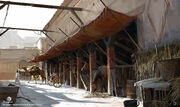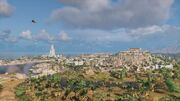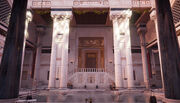(→Trivia: Don't know if this is historical or not, no evidence found for these being in Alexandria but the game based it mostly on Roman architecture soo...) |
|||
| (3 intermediate revisions by 3 users not shown) | |||
| Line 1: | Line 1: | ||
{{Era|Locations}} |
{{Era|Locations}} |
||
{{WP-REAL}} |
{{WP-REAL}} |
||
| − | {{Update|''[[Assassin's Creed: Desert Oath]]''}} |
+ | {{Update|''[[Assassin's Creed: Desert Oath]]'', ''[[Discovery Tour: Ancient Egypt]]''}} |
{{Quote|Alexandria is where the whole world meets, where every language under the sun is spoken on its streets, where Greeks and Egyptians walk together, where the Jews have their own temples even—and scholars from around the world come to study at the great Museum and Library.|[[Amunet|Aya]]|Assassin's Creed: Desert Oath}} |
{{Quote|Alexandria is where the whole world meets, where every language under the sun is spoken on its streets, where Greeks and Egyptians walk together, where the Jews have their own temples even—and scholars from around the world come to study at the great Museum and Library.|[[Amunet|Aya]]|Assassin's Creed: Desert Oath}} |
||
{{Location_Infobox |
{{Location_Infobox |
||
| Line 29: | Line 29: | ||
==History== |
==History== |
||
===Ptolemaic era=== |
===Ptolemaic era=== |
||
| − | Founded by Alexander the Great in 331 BCE, the [[polis]] of Alexandria was incorporated into the fledgling kingdom of [[Ptolemy I Soter]] in 323 BCE. During that year, Ptolemy hijacked the sarcophagus of Alexander, which was on its way to [[Macedonia]] at the time, and later buried the king in a [[Tomb of Alexander the Great|tomb]] in the city. Sometime during the reign of [[Ptolemy XII Auletes]], an earthquake struck the city, causing considerable damage to Alexander's tomb.<ref name=" |
+ | Founded by Alexander the Great in 331 BCE, the [[polis]] of Alexandria was incorporated into the fledgling kingdom of [[Ptolemy I Soter]] in 323 BCE. During that year, Ptolemy hijacked the sarcophagus of Alexander, which was on its way to [[Macedonia]] at the time, and later buried the king in a [[Tomb of Alexander the Great|tomb]] in the city. Sometime during the reign of [[Ptolemy XII Auletes]], an earthquake struck the city, causing considerable damage to Alexander's tomb.<ref name="Aya: Blade of the Goddess" /> |
| − | In 49 BCE, the pharaoh [[Cleopatra]] was exiled by her brother and co-ruler, [[Ptolemy XIII]] with the help of the [[Order of the Ancients]]. [[Apollodorus]], one of Cleopatra's loyal followers, helped her to escape the city through the canals.<ref name=" |
+ | In 49 BCE, the pharaoh [[Cleopatra]] was exiled by her brother and co-ruler, [[Ptolemy XIII]] with the help of the [[Order of the Ancients]]. [[Apollodorus]], one of Cleopatra's loyal followers, helped her to escape the city through the canals.<ref name="Co-rule with Ptolemy XIII & Exile">''[[Discovery Tour: Ancient Egypt]]'' – [[Discovery Tour: Ancient Egypt#Cleopatra, Queen of Egypt|Cleopatra, Queen on Egypt: "Co-rule with Ptolemy XIII & Exile"]]</ref> |
| − | A year later in 48 BCE, [[Amunet|Aya]], seeking revenge for the death of her son [[Khemu]], killed two members of the Ancients, [[Actaeon]], and [[Ktesos]].<ref name="Aya Memory">''Assassin's Creed: Origins'' – [[Aya (memory)|Aya]]</ref> Following this, her husband, the [[Medjay]] [[Bayek]] killed another member, [[Eudoros]], in the bathhouse of Alexandria.<ref>''Assassin's Creed: Origins'' - [[End of the Snake]]</ref> |
+ | A year later in 48 BCE, [[Amunet|Aya]], seeking revenge for the death of her son [[Khemu]], killed two members of the Ancients, [[Actaeon]], and [[Ktesos]].<ref name="Aya Memory">''[[Assassin's Creed: Origins]]'' – [[Aya (memory)|Aya]]</ref> Following this, her husband, the [[Medjay]] [[Bayek]] killed another member, [[Eudoros]], in the bathhouse of Alexandria.<ref>''[[Assassin's Creed: Origins]]'' - [[End of the Snake]]</ref> |
| − | In September, the [[Rome|Roman]] general [[Julius Caesar]] travelled to Alexandria in pursuit of his rival [[Pompey]], who had fled to Egypt. There, Caesar was received by Ptolemy XIII, who presented the head of the deceased Pompey to the general. Their meeting was interrupted with the arrival of Cleopatra with the help of Aya, Bayek and Apollodorus.<ref>''Assassin's Creed: Origins'' – [[Aya: Blade of the Goddess]]</ref> |
+ | In September, the [[Rome|Roman]] general [[Julius Caesar]] travelled to Alexandria in pursuit of his rival [[Pompey]], who had fled to Egypt. There, Caesar was received by Ptolemy XIII, who presented the head of the deceased Pompey to the general. Their meeting was interrupted with the arrival of Cleopatra with the help of Aya, Bayek and Apollodorus.<ref name="Aya: Blade of the Goddess">''[[Assassin's Creed: Origins]]'' – [[Aya: Blade of the Goddess]]</ref> |
| − | At the beginning of the year 47 BCE, Ptolemy [[Siege of Alexandria|besiedged]] the city with his army in an attempt to trap Cleopatra and the Romans. Bayek and Aya helped Caesar to defend the city.<ref |
+ | At the beginning of the year 47 BCE, Ptolemy [[Siege of Alexandria|besiedged]] the city with his army in an attempt to trap Cleopatra and the Romans. Bayek and Aya helped Caesar to defend the city.<ref>''[[Assassin's Creed: Origins]]'' – [[The Battle of the Nile]]</ref> |
| − | In 30 BCE, the Roman army led by [[Octavian]] invaded Alexandria. Aya, now known as the [[Hidden One]] Amunet, confronted Cleopatra in her palace. Amunet handed her a vial of [[Snakes|asp]] extract, allowing her to commit suicide, promising Cleopatra to take her son [[Caesarion]], with her to Rome and train him as one of them.<ref>''[[Assassin's Creed II]]''</ref><ref>[[Assassin's Creed: Origins (comic)|''Assassin's Creed: Origins'' |
+ | In 30 BCE, the [[Roman army]] led by [[Octavian]] invaded Alexandria.<ref>[[Assassin's Creed: Origins (comic)|''Assassin's Creed: Origins'']] – [[Assassin's Creed: Origins 1|Issue #01]]</ref> Cleopatra watched as the Roman army approached as her son [[Caesarion]] trained with the guard. Getting beaten, Cleopatra told her son that he must remain strong.<ref>[[Assassin's Creed: Origins (comic)|''Assassin's Creed: Origins'']] – [[Assassin's Creed: Origins 2|Issue #02]]</ref> With Octavian's men closing in, Cleopatra, Caesarion, and their guard walked outside. Once the guard left they were attacked, Caesarion bravely defended his mother who encouraged him to kill them attacker. Deducing that their guard had betrayed they waited for his return and killed him too.<ref>[[Assassin's Creed: Origins (comic)|''Assassin's Creed: Origins'']] – [[Assassin's Creed: Origins 3|Issue #03]]</ref> Aya, now known as the [[Hidden One]] Amunet, confronted Cleopatra in her palace. Amunet handed her a vial of [[Snakes|asp]] extract, allowing her to commit suicide, promising Cleopatra to take her son [[Caesarion]], with her to Rome and train him as one of them.<ref>''[[Assassin's Creed II]]''</ref><ref>[[Assassin's Creed: Origins (comic)|''Assassin's Creed: Origins'']] – [[Assassin's Creed: Origins 4|Issue #04]]</ref> |
===Roman era=== |
===Roman era=== |
||
| − | In 295 CE, the [[Roman Empire|Roman Emperor]] [[Diocletian]] attacked the city, which fell after eight months of relentless assault.<ref name=" |
+ | In 295 CE, the [[Roman Empire|Roman Emperor]] [[Diocletian]] attacked the city, which fell after eight months of relentless assault.<ref name="Impregnable Defense">''[[Discovery Tour: Ancient Egypt]]'' – [[Discovery Tour: Ancient Egypt#Alexandria: Planning of the City|Alexandria: Planning of the City: "Impregnable Defense"]]</ref> |
In 357, [[Constantius II]] had an [[Obelisk of Theodosius|obelisk]] built by [[Thutmose III]] in [[Karnak]] pilfered and transported to Alexandria. After remaining there for 40 years, Emperor [[Theodosius I]] transferred it to [[Constantinople]].<ref>''[[Assassin's Creed: Revelations]]'' – [[Database: Obelisk of Theodosius]]</ref> |
In 357, [[Constantius II]] had an [[Obelisk of Theodosius|obelisk]] built by [[Thutmose III]] in [[Karnak]] pilfered and transported to Alexandria. After remaining there for 40 years, Emperor [[Theodosius I]] transferred it to [[Constantinople]].<ref>''[[Assassin's Creed: Revelations]]'' – [[Database: Obelisk of Theodosius]]</ref> |
||
===Islamic era=== |
===Islamic era=== |
||
| − | During the 1240s, the widow of the Assassin [[Sef Ibn-La'Ahad]] moved to the city with their children, after having spent some time in exile in [[Alamut]].<ref>''[[Assassin's Creed: The Secret Crusade]]''</ref> In 1257, Sef's brother [[Darim Ibn-La'Ahad|Darim]] moved to Alexandria to be with his family, after the [[Mongol Empire|Mongols]] started besieging the Assassins' fortress of [[Masyaf]].<ref name=" |
+ | During the 1240s, the widow of the Assassin [[Sef Ibn-La'Ahad]] moved to the city with their children, after having spent some time in exile in [[Alamut]].<ref>''[[Assassin's Creed: The Secret Crusade]]''</ref> In 1257, Sef's brother [[Darim Ibn-La'Ahad|Darim]] moved to Alexandria to be with his family, after the [[Mongol Empire|Mongols]] started besieging the Assassins' fortress of [[Masyaf]].<ref name="Darim and Sef">''[[Assassin's Creed: Revelations]]'' – [[Database: Darim and Sef]]</ref> |
| − | + | Years later, a descendant of Altaïr named [[Iskender]] became the [[Mentor]] of the Assassins in Egypt and was headquartered in Alexandria.<ref name="The Mentor Vanishes">''[[Assassin's Creed: Revelations]]'' – [[Mediterranean Defense#Alexandria|Mediterranean Defense: "The Mentor Vanishes"]]</ref> The [[Templars|Templar]] [[Odai Dunqas]] also relocated to the city sometime around 1505, after being driven away from his home by his family.<ref name="Odai Dunqas">''[[Assassin's Creed: Revelations]]'' – [[Database: Odai Dunqas]]</ref> |
|
| + | In 1511, during an excavation of the destroyed [[Library of Alexandria]], the [[Mamluks|Mamluk Sultanate]]'s soldiers discovered two [[Memory Seals]] in a chest from 331 BCE. [[Ezio Auditore da Firenze|Ezio Auditore]] sent some Assassins from Constantinople to Alexandria to retrieve the seals.<ref name="The Memory Seals, Part I">''[[Assassin's Creed: Revelations]]'' – [[Mediterranean Defense#Alexandria|Mediterranean Defense: "The Memory Seals, Part I"]]</ref> After the seals were recovered, Templar soldiers launched an offensive on the Assassin headquarters. The Assassins fought hard to protect the initiate decoding the seals.<ref name="The Memory Seals, Part II">''[[Assassin's Creed: Revelations]]'' – [[Mediterranean Defense#Alexandria|Mediterranean Defense: "The Memory Seals, Part II"]]</ref> However, the Templars later reacquired the seals. A search party was sent out, authorized to use maximum force.<ref name="The Memory Seals, Part III">''[[Assassin's Creed: Revelations]]'' – [[Mediterranean Defense#Alexandria|Mediterranean Defense: "The Memory Seals, Part III"]]</ref> |
||
| − | The [[Templars|Templar]] [[Odai Dunqas]] also relocated to the city sometime around 1505, after being driven away from his home by his family.<ref name="Revelations" /> |
||
| + | Sometime later, The Egyptian Mentor Iskender was captured by Templars and scheduled for execution, Ezio sent some Assassins to save him from his demise.<ref name="The Mentor Vanishes">''[[Assassin's Creed: Revelations]]'' – [[Mediterranean Defense#Alexandria|Mediterranean Defense: "The Mentor Vanishes"]]</ref> |
||
| − | In 1511, during an excavation of the destroyed [[Library of Alexandria]], the [[Mamluks|Mamluk Sultanate]]'s soldiers discovered two [[Memory Seals]] in a chest from 331 BCE. Ezio Auditore sent some Assassins from Constantinople to Alexandria to retrieve the seals.<ref name="Revelations" /> |
||
==Locations== |
==Locations== |
||
| Line 79: | Line 79: | ||
*[[South Wall Guard Post]] |
*[[South Wall Guard Post]] |
||
| + | ==Behind the scenes== |
||
| − | ==Trivia== |
||
| − | + | The rich district houses have wall paintings that are actually characteristic of Roman wall painting.<ref>[https://www.ancient.eu/article/597/roman-wall-painting/ ''Ancient History Encyclopedia'' – Roman Wall Painting]</ref> The in-game patterns resemble the ones found on the terrace houses of ancient {{Wiki|Ephesus}}. The city has Roman style raised stone pedestrian crosswalks. |
|
| − | *There are Roman style raised stone pedestrian crosswalks. |
||
==Gallery== |
==Gallery== |
||
| Line 108: | Line 107: | ||
Assasins-creed-origins-gamescom-3.jpg|Alexandria at night as seen from the Serapeum |
Assasins-creed-origins-gamescom-3.jpg|Alexandria at night as seen from the Serapeum |
||
Overview of Alexandria.jpg|Overview of Alexandria |
Overview of Alexandria.jpg|Overview of Alexandria |
||
| + | ACO Alexandria Bathhouse.jpg|Bathhouse |
||
| + | ACO Alexandria Bathhouse 2.jpg |
||
| + | ACO Alexandria Bathhouse 3.jpg |
||
| + | ACO Alexandria Bathhouse 4.jpg |
||
| + | ACO Alexandria Bathhouse 5.jpg |
||
</gallery> |
</gallery> |
||
</tabber> |
</tabber> |
||
Revision as of 03:22, 13 June 2020

|
Patience, brothers. Soon we will reveal the secrets of Assassin's Creed: Desert Oath, Discovery Tour: Ancient Egypt. This article has been identified as being out of date. Please update the article to reflect recent releases and then remove this template once done. |
Alexandria is the second largest city of Egypt, located along the coast of the Mediterranean Sea. It is named after the Macedonian king Alexander the Great, who founded the city around 331 BCE. A Hellenistic city, it served as the capital of Egypt throughout the Ptolemaic dynasty. It had so much commercial and intellectual development, that it became the most flourished city of the Ptolemaic era.
History
Ptolemaic era
Founded by Alexander the Great in 331 BCE, the polis of Alexandria was incorporated into the fledgling kingdom of Ptolemy I Soter in 323 BCE. During that year, Ptolemy hijacked the sarcophagus of Alexander, which was on its way to Macedonia at the time, and later buried the king in a tomb in the city. Sometime during the reign of Ptolemy XII Auletes, an earthquake struck the city, causing considerable damage to Alexander's tomb.[1]
In 49 BCE, the pharaoh Cleopatra was exiled by her brother and co-ruler, Ptolemy XIII with the help of the Order of the Ancients. Apollodorus, one of Cleopatra's loyal followers, helped her to escape the city through the canals.[2]
A year later in 48 BCE, Aya, seeking revenge for the death of her son Khemu, killed two members of the Ancients, Actaeon, and Ktesos.[3] Following this, her husband, the Medjay Bayek killed another member, Eudoros, in the bathhouse of Alexandria.[4]
In September, the Roman general Julius Caesar travelled to Alexandria in pursuit of his rival Pompey, who had fled to Egypt. There, Caesar was received by Ptolemy XIII, who presented the head of the deceased Pompey to the general. Their meeting was interrupted with the arrival of Cleopatra with the help of Aya, Bayek and Apollodorus.[1]
At the beginning of the year 47 BCE, Ptolemy besiedged the city with his army in an attempt to trap Cleopatra and the Romans. Bayek and Aya helped Caesar to defend the city.[5]
In 30 BCE, the Roman army led by Octavian invaded Alexandria.[6] Cleopatra watched as the Roman army approached as her son Caesarion trained with the guard. Getting beaten, Cleopatra told her son that he must remain strong.[7] With Octavian's men closing in, Cleopatra, Caesarion, and their guard walked outside. Once the guard left they were attacked, Caesarion bravely defended his mother who encouraged him to kill them attacker. Deducing that their guard had betrayed they waited for his return and killed him too.[8] Aya, now known as the Hidden One Amunet, confronted Cleopatra in her palace. Amunet handed her a vial of asp extract, allowing her to commit suicide, promising Cleopatra to take her son Caesarion, with her to Rome and train him as one of them.[9][10]
Roman era
In 295 CE, the Roman Emperor Diocletian attacked the city, which fell after eight months of relentless assault.[11]
In 357, Constantius II had an obelisk built by Thutmose III in Karnak pilfered and transported to Alexandria. After remaining there for 40 years, Emperor Theodosius I transferred it to Constantinople.[12]
Islamic era
During the 1240s, the widow of the Assassin Sef Ibn-La'Ahad moved to the city with their children, after having spent some time in exile in Alamut.[13] In 1257, Sef's brother Darim moved to Alexandria to be with his family, after the Mongols started besieging the Assassins' fortress of Masyaf.[14]
Years later, a descendant of Altaïr named Iskender became the Mentor of the Assassins in Egypt and was headquartered in Alexandria.[15] The Templar Odai Dunqas also relocated to the city sometime around 1505, after being driven away from his home by his family.[16]
In 1511, during an excavation of the destroyed Library of Alexandria, the Mamluk Sultanate's soldiers discovered two Memory Seals in a chest from 331 BCE. Ezio Auditore sent some Assassins from Constantinople to Alexandria to retrieve the seals.[17] After the seals were recovered, Templar soldiers launched an offensive on the Assassin headquarters. The Assassins fought hard to protect the initiate decoding the seals.[18] However, the Templars later reacquired the seals. A search party was sent out, authorized to use maximum force.[19]
Sometime later, The Egyptian Mentor Iskender was captured by Templars and scheduled for execution, Ezio sent some Assassins to save him from his demise.[15]
Locations
Military locations
Papyrus locations
Treasure locations
- Aya's Home
- Armory
- Emporion Berthed Trireme
- Mareia Military Storage
- Mareia Trireme
- Narrow Crevice
- Pharos Military Storage
- Ptolemaic Royal Palace
- South Wall Guard Post
Behind the scenes
The rich district houses have wall paintings that are actually characteristic of Roman wall painting.[20] The in-game patterns resemble the ones found on the terrace houses of ancient Ephesus. The city has Roman style raised stone pedestrian crosswalks.
Gallery
Appearances
- Assassin's Creed II (mentioned only)
- Assassin's Creed: Revelations (mentioned only)
- Assassin's Creed: Origins (first appearance)
- Assassin's Creed: Desert Oath
- Assassin's Creed: Origins comic
References
- ↑ 1.0 1.1 Assassin's Creed: Origins – Aya: Blade of the Goddess
- ↑ Discovery Tour: Ancient Egypt – Cleopatra, Queen on Egypt: "Co-rule with Ptolemy XIII & Exile"
- ↑ Assassin's Creed: Origins – Aya
- ↑ Assassin's Creed: Origins - End of the Snake
- ↑ Assassin's Creed: Origins – The Battle of the Nile
- ↑ Assassin's Creed: Origins – Issue #01
- ↑ Assassin's Creed: Origins – Issue #02
- ↑ Assassin's Creed: Origins – Issue #03
- ↑ Assassin's Creed II
- ↑ Assassin's Creed: Origins – Issue #04
- ↑ Discovery Tour: Ancient Egypt – Alexandria: Planning of the City: "Impregnable Defense"
- ↑ Assassin's Creed: Revelations – Database: Obelisk of Theodosius
- ↑ Assassin's Creed: The Secret Crusade
- ↑ Assassin's Creed: Revelations – Database: Darim and Sef
- ↑ 15.0 15.1 Assassin's Creed: Revelations – Mediterranean Defense: "The Mentor Vanishes"
- ↑ Assassin's Creed: Revelations – Database: Odai Dunqas
- ↑ Assassin's Creed: Revelations – Mediterranean Defense: "The Memory Seals, Part I"
- ↑ Assassin's Creed: Revelations – Mediterranean Defense: "The Memory Seals, Part II"
- ↑ Assassin's Creed: Revelations – Mediterranean Defense: "The Memory Seals, Part III"
- ↑ Ancient History Encyclopedia – Roman Wall Painting
| |||||||||||
| |||||||||||||||||||||||||























